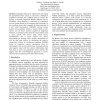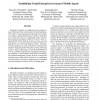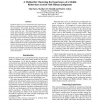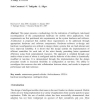717 search results - page 84 / 144 » Autonomous mobility skeletons |
ICRA
2002
IEEE
14 years 19 days ago
2002
IEEE
Sampling multisensory information and taking the appropriate motor action is critical for a biological organism’s survival, but a difficult task for robots. We present a Neurally...
CDC
2009
IEEE
14 years 13 days ago
2009
IEEE
—We propose a tracking control with collision avoidance for a group of unicycle mobile robots. A supervisory system assigns to each robot its reference path, together with the de...
RIDE
1999
IEEE
13 years 12 months ago
1999
IEEE
Electronic Commerce is expanding from the simple notion of Electronic Store to the notion of Virtual Enterprises (VE) where existing enterprises dynamically form temporary allianc...
AAAI
2000
13 years 9 months ago
2000
If robotic agents are to act autonomously they must have the ability to construct and reason about models of their physical environment. For example, planning to achieve goals req...
JIRS
2007
13 years 7 months ago
2007
This paper presents a methodology for the realization of intelligent, task-based reconfiguration of the computational hardware for mobile robot applications. Task requirements are ...



